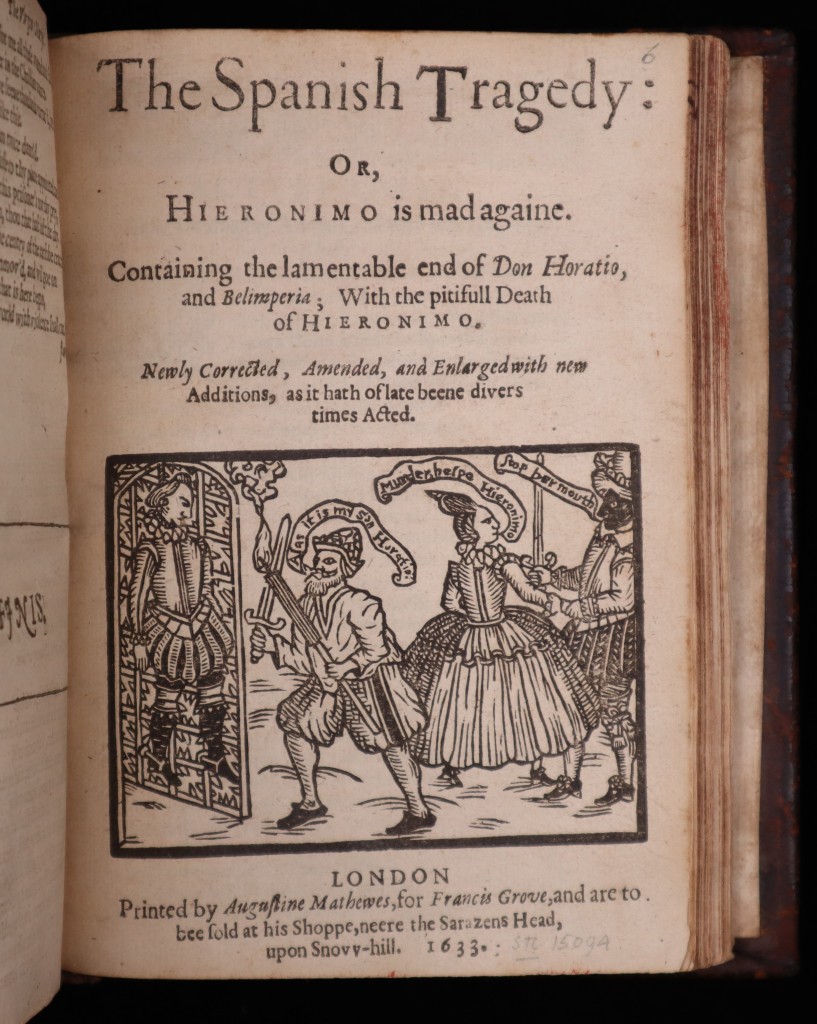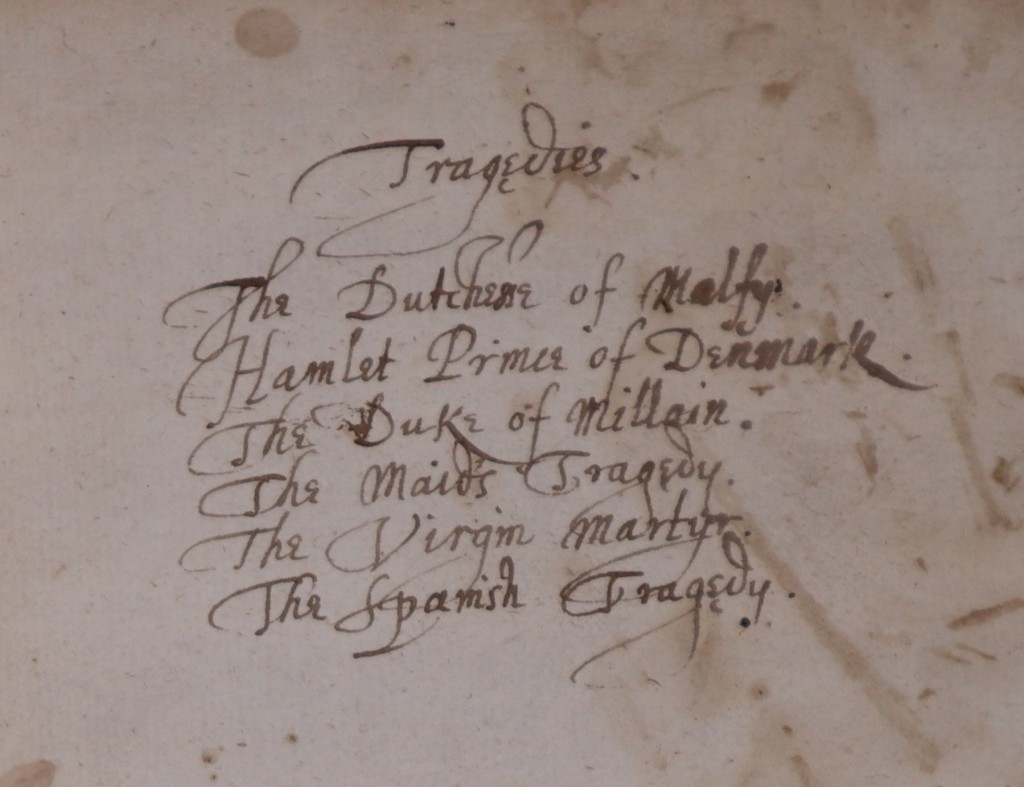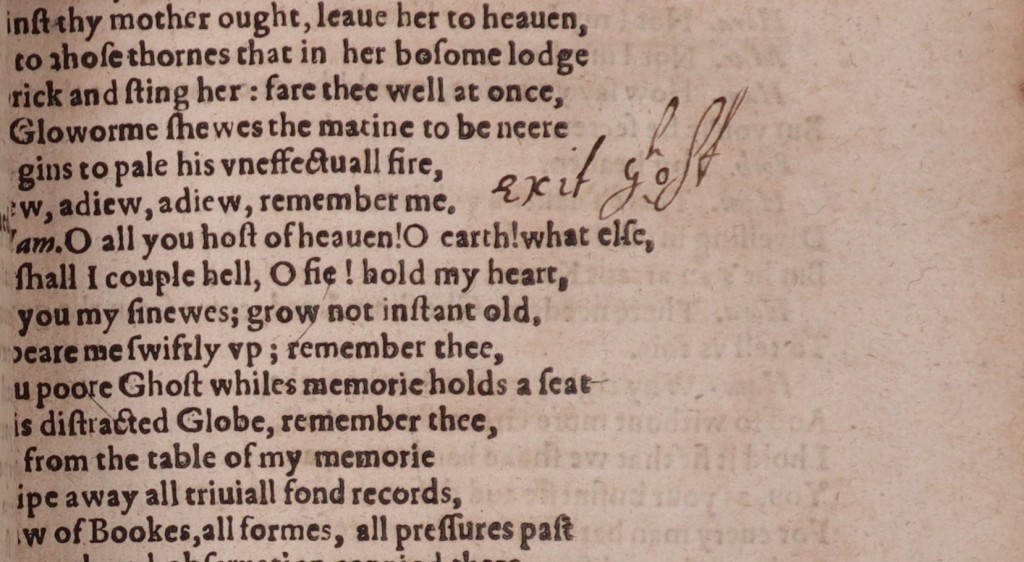These unassuming volumes may have belonged to a lesser-known figure of seventeenth-century Magdalene history: James Duport, former Master and dean of Peterborough. They are both volumes of play quartos: small collections of Renaissance drama, likely bought and bound to be read aloud in the home. Pepys, a relative contemporary of Duport, notes that on 13th November 1664 he ‘spent all the afternoon with my wife within doors, and getting a speech out of Hamlett, “To bee or not to bee.”’[1]
The second volume of the pair, bound in brown calf, almost certainly belonged to Duport. This is indicated by the manuscript contents page, likely written in Duport’s hand, that precedes the plays. It is a collection of tragedies, including the well-known Duchess of Malfi, The Spanish Tragedy, and Hamlet. A careful annotation of this last play clears up a matter of staging, “exit ghost” being written in the margin.
Though the first collection of plays is of unknown provenance, it is, perhaps, more interesting than the second. This volume contains a fairly indiscriminate mix of tragedies and comedies, several of which were printed during the Civil War and subsequent interregnum, a period widely known for the Puritan ban on that expression of ‘lascivious Mirth and Levity,’ the theatre.[2] Though it may seem counterintuitive that such raucous plays were printed while London’s theatres were being actively demolished, it has been argued that the lack of consistent government during the war and commonwealth led to a flourishing market of print culture, no longer supervised – or suppressed – by the Star Court or Company of Stationers; a ‘watershed’ moment in bibliographic history in which ‘surreptitious playing’ was accompanied by surreptitious printing.[3] At the back of this volume, we find some considerable marginalia, indicating that this book was not, perhaps, always treated as a treasure of its owner’s library. An itemised list of expenses for a trip north to Lincolnshire notes a cost of eight ‘shelens’ ‘for a pare of boutes and shoues’.
Duport had both royalist sympathies and an impressive library of some 2000 books, now in the collection of Trinity College, Cambridge. A smaller collection held at his residence in Peterborough were bequeathed to Magdalene, however, and it is from this group that the two playbooks were perhaps sourced.[4] It was under Duport’s mastership that plans were put into place for the Pepys Library, and his own published works reveal ‘a man of enormous breadth of reading.’[5] Though Duport disabused his students from reading ‘“profane, scurrilous, unsavoury, rotten frothy communications,”’ he clearly did not include these so-called ‘baggage books’ in the same class.[6] Indeed, reports that Duport was widely known as ‘a man of diminutive stature and possessed of a good sense of humour and some wit,’ and his election as an undergraduate to the role of praevaricator – an ‘official humourist’ brought in to satirise an academic proposal before its defence– suggests that Duport may well have seen the value in collecting comedies, even as his Magdalene near-contemporary Pepys writes that the raucous and bawdy Knight of the Burning Pestle ‘pleased me not at all.’[7]
By Grace Collingwood
Library Graduate Trainee
All images used in this blog are the copyright of the Master and Fellows of Magdalene College Cambridge. To reproduce these images in any format, including online, permission from the College must be sought. For further information please see the College website.
[1] Pepys, Samuel, The Diary of Samuel Pepys, vol. V, ed. by Robert Latham and William Matthews (London: G. Bell and Sons), 1971, p.320
[2] Butler, Martin, ‘The Condition of the Theatres in 1642,’ in The Cambridge History of British Theatre : Vol I, Origins to 1660 (Cambridge: Cambridge University Press, 2004), p.439.
[3] Spurlock, R. Scott, “Cromwell’s Edinburgh Press and the Development of Print Culture in Scotland.” The Scottish Historical Review, vol. 90, no. 230, 2011, pp. 179–203, p.179, and Butler, p.441.
[4] https://bookowners.online/James_Duport_1606-1679
[5] Cunich, Peter, et al, A History of Magdalene College Cambridge, 1428-1988 (Magdalene College Publications, Cambridge), 1994, p.147.
[6] Cunich, et al, p.148, and Lyons, Tara L., “Baggage Bookes” and the Shakespeare First Folio:
Towards a Critical Historiography of the Book, Shakespeare Quarterly, Volume 74, Number 4, Winter 2023, pp. 387-395, p.387.
[7] Costello, William T, ‘A Cambridge Prevarication in the Earlier Seventeenth Century’, Renaissance News, vol. 8, no. 4, 1955, pp. 179–84, p.179, and Pepys, vol III, p.78.




Hi, I have just finished an autobiography of one of your alumni, Eric Fernihough 1923-1926, if you would like some details which are attached. Published in August.
It’s a serious and weighty book but maybe not your sort of thing 🙂
Let me know if you would like a copy in the library and I will donate one but I would appreciate a bit of publicity for what has been a labour of love over a number of years.
Regards
Terry Wright
Dear Terry, many thanks for your message. If you wouldn’t mind emailing pepyslibrary@magdlibs.com so that we have an official log of your offer and request, the library team can discuss this further with you. Best wishes, Magdalene College Libraries.